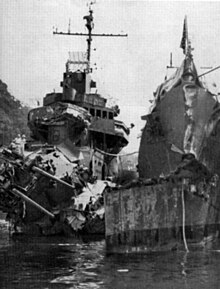Battle of Vella Lavella
| date | October 6, 1943 |
|---|---|
| place | in front of Vella Lavella , Solomon Islands , Pacific |
| output | Japanese victory |
| Parties to the conflict | |
|---|---|
| Commander | |
| Troop strength | |
| 6 destroyers | 9 destroyers 20 barges transport ships |
| losses | |
|
1 destroyer sunk. |
1 destroyer sunk |
The naval battle at Vella Lavella was a battle between the United States of America and Japan during the Pacific War . It took place on the night of October 6-7 , 1943 near Vella Lavella in the Solomon Islands .
prehistory
After the lost battle in the Vella Gulf, the Japanese evacuated their troops . In Horaniu, at the northernmost point of Vella Lavella, they had set up a loading point for their barges . In October 1943, six hundred soldiers remained to be evacuated. A flotilla consisting of the nine destroyers Fumitsuki '' , Matsukaze , Yunagi , Akigumo , Isokaze , Kazegumo , Yūgumo , Shigure , Samidare , some barges and supply ships was assigned to pick up these troops.
The battle

At 10:30 p.m., an American formation consisting of the three destroyers Selfridge , Chevalier , O'Bannon under the command of Captain Frank R. Walker discovered the Japanese ships. He did not wait for the second formation, consisting of the destroyers Ralph Talbot , Taylor , La Vallette , but went straight to the attack. Both sides fired torpedoes and opened artillery fire at 11:00 p.m.
The Yūgumo , the first ship in the Japanese line, was hit at the rudder, which made her unable to maneuver. However, one of their torpedoes hit the Chevalier , which caused the front ammunition chamber to explode. The O'Bannon collided with the damaged Chevalier due to the restricted visibility caused by the smoke from the guns and the two ships were entangled for a while.
Another torpedo struck the Selfridge and tore off the bow between the first and second turrets. With the remaining American destroyers still taking 15 minutes to arrive, the Japanese had enough time to escape.
Result
The Chevalier could not be held by the three damaged destroyers and was sunk by La Vallette at 3:00 a.m. The Japanese Navy , whose destroyer Yūgumo was hit by another torpedo and sank, was able to successfully continue its evacuation mission.
This was the last Japanese victory in a sea battle in that war.
literature
Samuel Eliot Morison : Breaking the Bismarck's Barrier . History of United States Naval Operations in World War II, Vol. 6. Edison (New Jersey, USA) 1958 (reprinted 2001), pp. 243-253. ISBN 0785813071 .
Web links
- Jon Parshall, Bob Hackett, Sander Kingsepp, & Allyn Nevitt: The Battle of Vella Lavella (Combinedfleet.com) . Retrieved April 23, 2010 - (in English)
